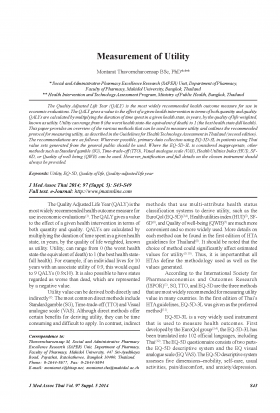This website uses cookies so that we can provide you with the best user experience possible. Cookie information is stored in your browser and performs functions such as recognising you when you return to our website and helping our team to understand which sections of the website you find most interesting and useful.
Measurement of Utility (2014)

รายละเอียดเพิ่มเติม
Montarat Thavorncharoensap BSc, PhD*,**
* Social and Administrative Pharmacy Excellence Research (SAPER) Unit, Department of Pharmacy,
Faculty of Pharmacy, Mahidol University, Bangkok, Thailand
** Health Intervention and Technology Assessment Program, Ministry of Public Health, Bangkok, Thailand
The Quality Adjusted Life Year (QALY) is the most widely recommended health outcome measure for use in economic evaluations. The QALY gives a value to the effect of a given health intervention in terms of both quantity and quality. QALYs are calculated by multiplying the duration of time spent in a given health state, in years, by the quality of life weighted, known as utility. Utility can range from 0 (the worst health state-the equivalent of death) to 1 (the best health state-full health). This paper provides an overview of the various methods that can be used to measure utility and outlines the recommended protocol for measuring utility, as described in the Guidelines for Health Technology Assessment in Thailand (second edition). The recommendations are as follows: Wherever possible, primary data collection using EQ-5D-3L in patients using Thai value sets generated from the general public should be used. Where the EQ-5D-3L is considered inappropriate, other methods such as Standard gamble (SG), Time-trade-off (TTO), Visual analogue scale (VAS), Health Utilities Index (HUI), SF-6D, or Quality of well being (QWB) can be used. However, justification and full details on the chosen instrument should
always be provided.
J Med Assoc Thai 2014; 97 (Suppl. 5): S43-S49
Full text. e-Journal: http://www.jmatonline.com




